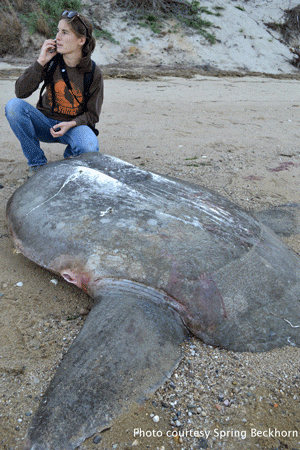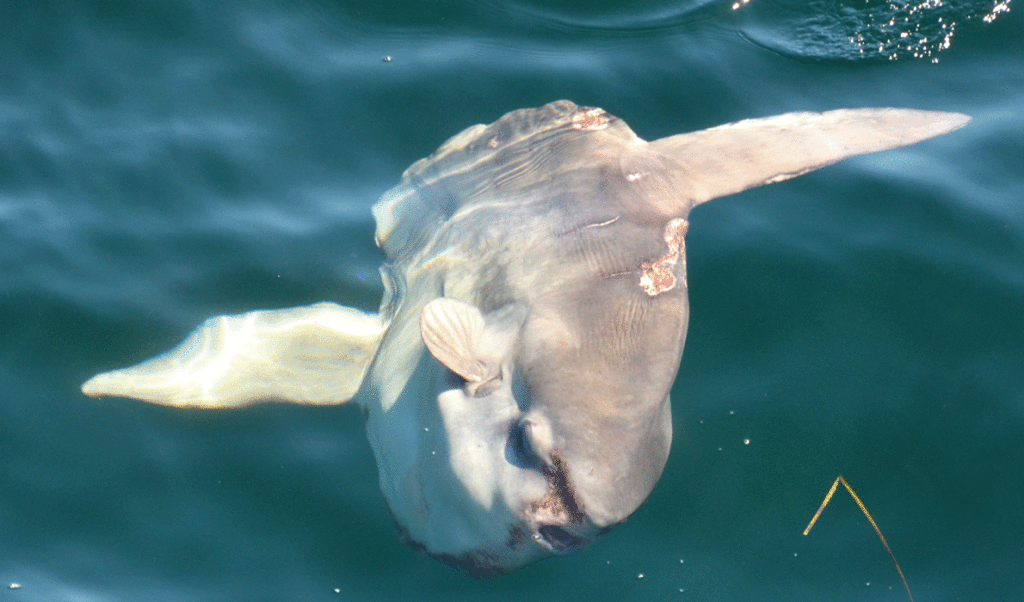By Wanda Curtis
One of the largest fish increasingly seen in the Gulf of Maine is the Mola mola, or ocean sunfish. These gentle giants, which can grow up to 5,000 pounds, are found in temperate and tropical oceans throughout the world.
It’s been nicknamed the “swimming head” because the head is so large that, at a quick glance, it appears to be without a body. Mola can have eyes as big as grapefruits.
Until recently, there were only occasional reports of Mola mola in Maine waters. This past summer, however, the number of reports increased.
Marine biologist Carol “Krill” Carson said that six sightings were reported through her website www.nebshark.org, compared to only one sighting reported last year.
Carson said this year’s sightings were reported from Muscongus Bay, Tantas Ledge off Cape Elizabeth, off Owls Head lighthouse, Jericho Bay between Johns Island and Mahoney Island, West Penobscot Bay between Camden and Rockport, and Casco Bay.
Carson is president of the nonprofit New England Coastal Wildlife Alliance (NECWA) which works rescuing stranded Mola in Massachusetts and in gathering data about the fish. She encourages the public to report any sighting through her website to help scientists gather more information about where these fish travel and how they live.
Walt Golet, an assistant research professor at the University of Maine’s School of Marine Sciences, isn’t convinced there’s actually been an increase in Mola mola in Maine waters this year. He suggests the public is becoming more aware of the fish, which could explain increased reporting.
It also is possible that more fish are traveling closer to shore where they can be seen, Golet said. Most of the Mola he has seen in Maine waters in recent years were observed in deeper waters. Golet recalls seeing 12 Mola in one day while harpooning tuna earlier this summer.
“One change that I’ve noticed is that more small Mola—probably less than 100 pounds—have been coming into Maine the past few years,” he said. “I don’t know why that is. I’ve noticed that the smaller ones travel in groups, unlike the larger ones which usually travel alone.”
Another factor which may account for the increased number of Mola sightings is the large number of jellyfish in Maine waters this year. Jellyfish make up a large portion of the Mola’s diet.
But the most significant factor is the warming waters of the Gulf of Maine. The species seen here are most comfortable in waters in the 59-68 degrees Fahrenreit range.
Mola can’t survive for long in very cold water. They dive into deeper waters looking for food but don’t stay down long. After diving into colder water, they often return to the surface and lay on their side, basking in the sun, possibly to warm themselves, Golet said. They’re sometimes mistaken for a shark when their large dorsal fin emerges from the water.
Mola also are known for their breaching behavior. Golet reports that they can jump five feet or more above the surface of the water. It’s been suggested that they do this in an attempt to shake off the many parasites which cover their body.
“When they land on the water, it’s like a 4-by-8 sheet of plywood slamming down onto the water,” Golet said.
Marine biologist Tierney Thys has been studying Mola mola for almost 20 years and has traveled the globe in search of more information about these unique fish.
“Mola have a huge geographic distribution and are found in all tropical and temperate ocean basins,” Thys said. “Being widespread, producing lots of young, eating jellies, and growing very fast—at least in captivity—are all beneficial features in a fast-changing ocean and can reduce the chance of extinction.”

PHOTO: COURTESY SPRING BECKHORN
A dead mola mola on Great Island in Wellfleet, Mass.





